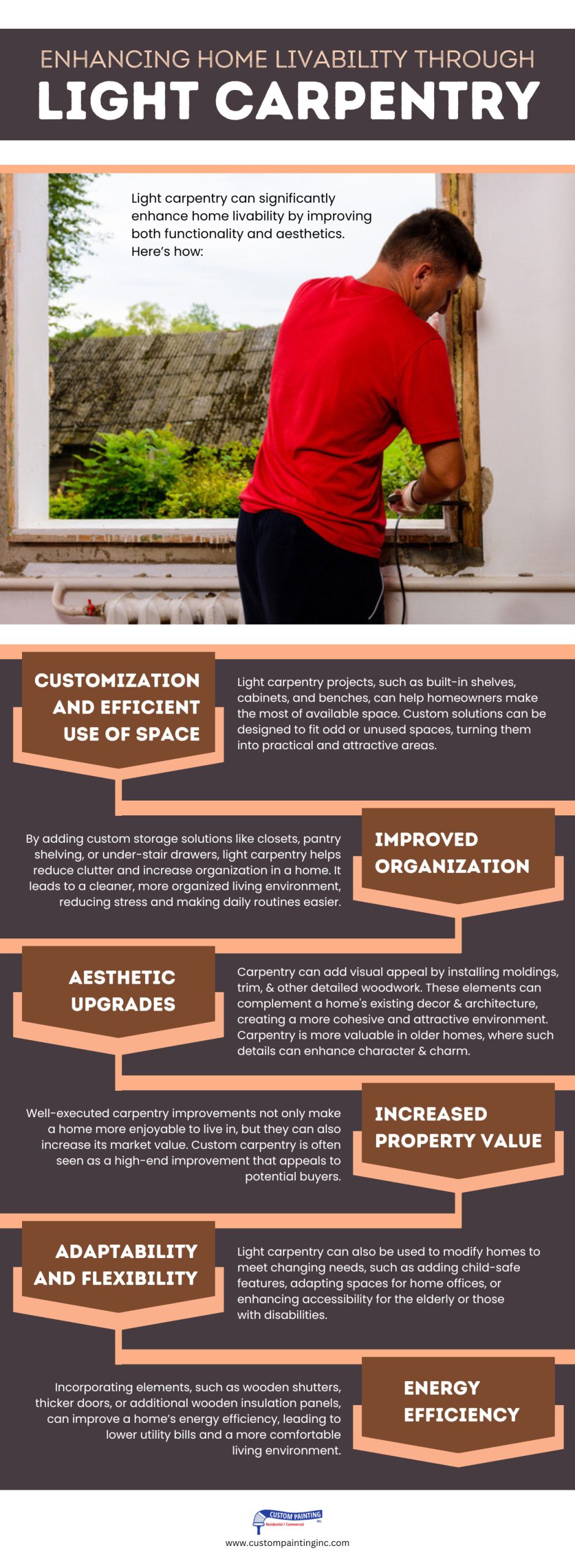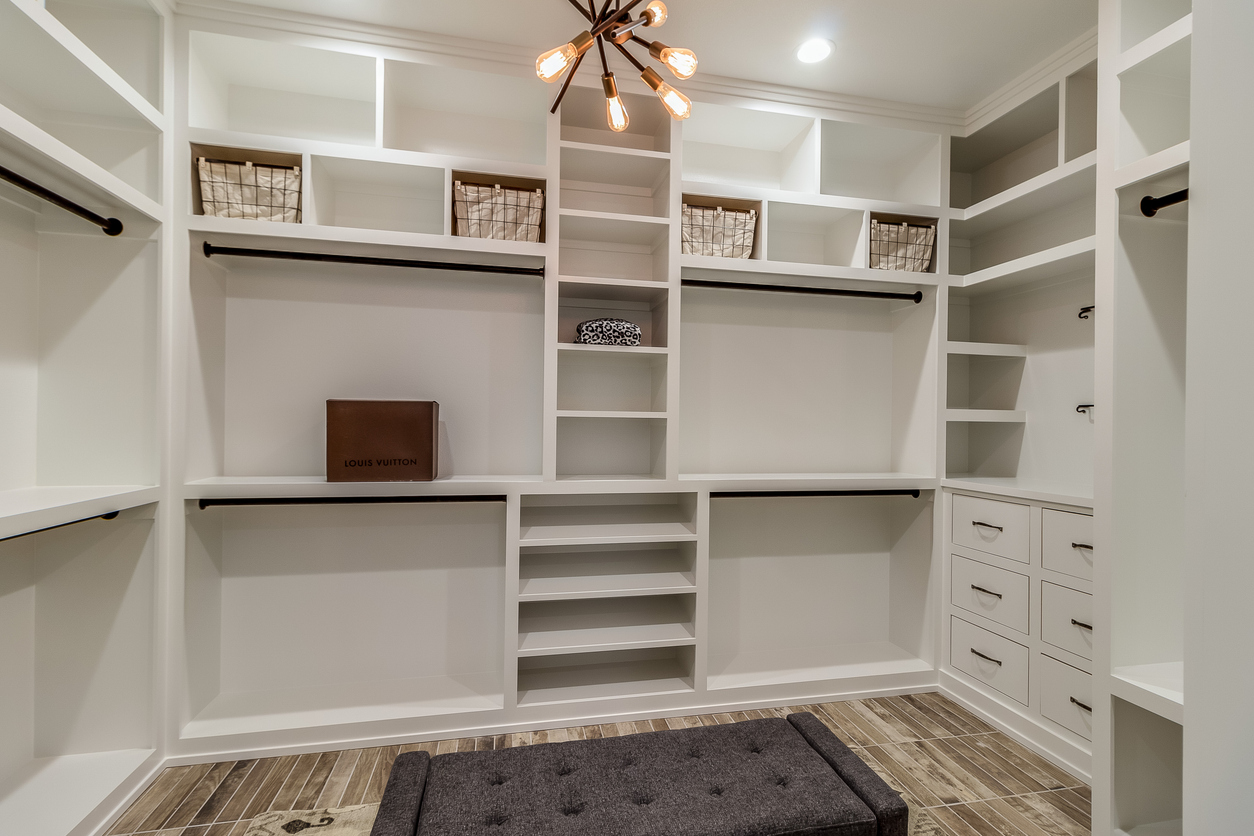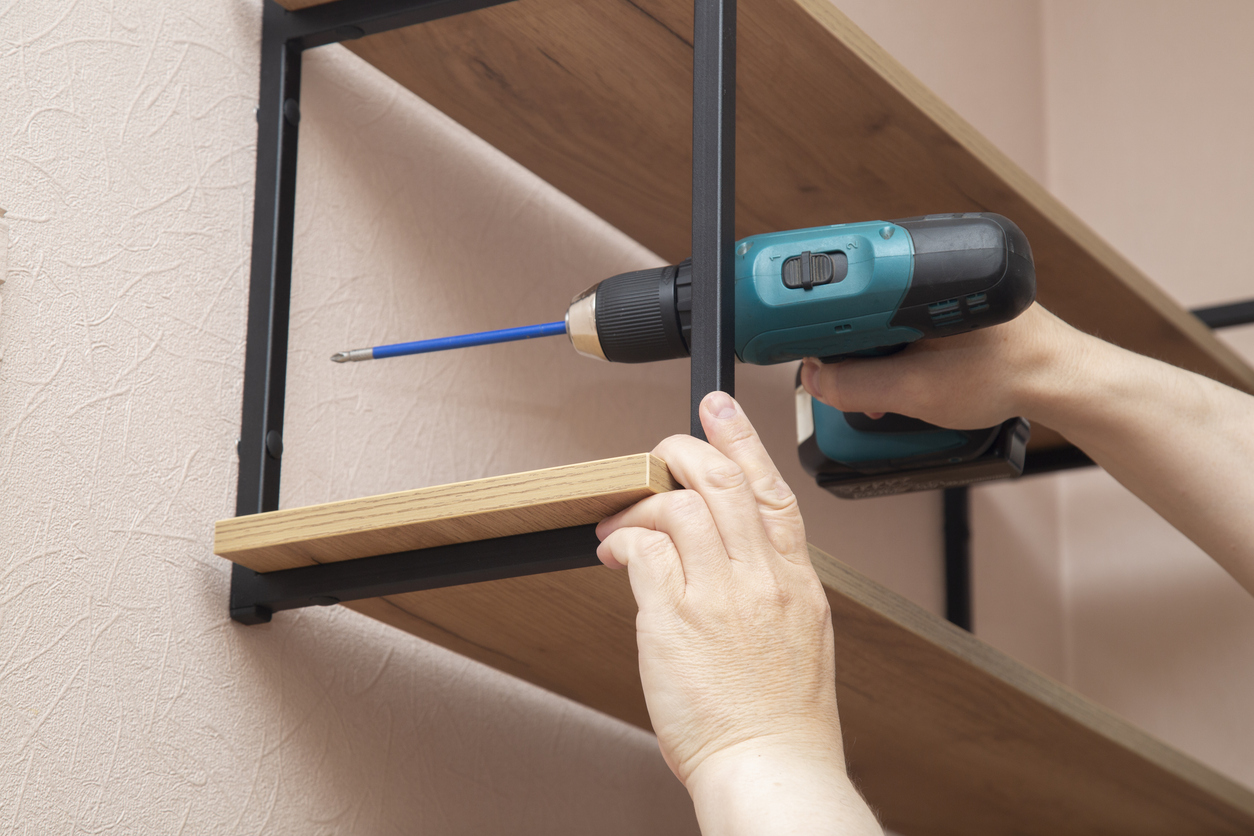Light carpentry involves smaller-scale woodworking tasks essential for home maintenance and improvement. These projects often require less technical skill and fewer heavy-duty tools than more intensive carpentry work, making them accessible for many homeowners. Examples include fixing or replacing trims, installing shelves, and leveling cabinet doors.
Even minor carpentry work can significantly impact a home’s value and livability. By addressing wear and tear and updating fixtures, homeowners can maintain the structural integrity of their property and refresh its appearance. This makes the living space more enjoyable and increases its market value. Complete your renovation with professional light carpentry work including trim installation and minor repairs.
This article’s scope explores how various light carpentry projects can enhance both the monetary value and the quality of life within a home. We will delve into different tasks that homeowners can undertake, discussing their potential returns on investment and how they contribute to making a home more functional and aesthetically pleasing.
Understanding light carpentry
Light carpentry refers to a range of simpler, less labor-intensive construction and woodworking tasks that are typically quicker and less invasive compared to more intensive carpentry work. Here are some common examples:
- Trim work–This type of work involves installing and finishing the trim around a home’s doors, windows, and baseboards. It’s primarily aesthetic and helps give rooms a more finished look.
- Crown molding installation–This trim work adds elegance to a room. Crown molding is installed at the junction of walls and ceilings, enhancing the architectural style of a space.
- Custom shelving—Light carpentry often includes designing and installing custom shelving units tailored to specific spaces or needs. These can range from simple bookshelves to more elaborate storage solutions.
- Minor repairs–This can encompass a variety of tasks, such as fixing squeaky doors, repairing broken trim, patching holes in woodwork, and other minor maintenance jobs that do not require extensive structural changes.
Differentiation from intensive carpentry work
Light carpentry is distinct from more intensive carpentry due to several key factors:
- Complexity and scope – Light carpentry usually involves smaller projects that don’t require altering the structural integrity of a building. Intensive carpentry might include framing new walls, constructing staircases, or other projects that affect the building’s framework.
- Time commitment—Light carpentry projects typically require less time to complete. Unlike intensive projects that take weeks or months, they can often be done within a day or two.
- Tools and materials – Light carpentry generally uses simpler tools and fewer materials, making it less disruptive and cost-effective.
- Skill level – While still requiring skill and precision, light carpentry is generally less technically demanding than more extensive carpentry work, possibly requiring advanced training and experience in construction techniques.
Light carpentry is well-suited for smaller home improvement projects that enhance aesthetics and functionality without major construction or long-term disruption.
Enhancing home livability through light carpentry
Light carpentry can significantly enhance home livability by improving both functionality and aesthetics. Here’s how:
- Customization and efficient use of space—Light carpentry projects, such as built-in shelves, cabinets, and benches, can help homeowners make the most of available space. Custom solutions can be designed to fit odd or unused spaces, turning them into practical and attractive areas.
- Improved organization–By adding custom storage solutions like closets, pantry shelving, or under-stair drawers, light carpentry helps reduce clutter and increase organization in a home. It leads to a cleaner, more organized living environment, reducing stress and making daily routines easier.
- Aesthetic upgrades—Carpentry can add visual appeal by installing moldings, trim, and other detailed woodwork. These elements can complement a home’s existing decor and architecture, creating a more cohesive and attractive environment. Carpentry is more valuable in older homes, where such details can enhance character and charm.
- Increased property value–Well-executed carpentry improvements not only make a home more enjoyable to live in, but they can also increase its market value. Custom carpentry is often seen as a high-end improvement that appeals to potential buyers.
- Adaptability and flexibility–Light carpentry can also be used to modify homes to meet changing needs, such as adding child-safe features, adapting spaces for home offices, or enhancing accessibility for the elderly or those with disabilities.
- Energy efficiency–Incorporating elements, such as wooden shutters, thicker doors, or additional wooden insulation panels, can improve a home’s energy efficiency, leading to lower utility bills and a more comfortable living environment.
Through these improvements, light carpentry makes a home more functional, beautiful, and adaptable to its occupants’ needs.
Increasing home value with light carpentry
Light carpentry projects can significantly enhance the value of your home by improving its overall appearance, functionality, and appeal to potential buyers. Here are several ways in which light carpentry can contribute to increasing home value:
- Improved aesthetics – Light carpentry projects like crown molding, wainscoting, and trim work can significantly enhance the visual appeal of a home. These details add character and elegance to rooms, making them appear more finished and luxurious. Improved aesthetics can make a home more attractive to potential buyers, potentially increasing its market value.
- Enhanced functionality and utility – Carpentry projects that improve the functionality of a space can also add value. For example, custom shelving, built-in cabinets, and closet organizers can make a home more practical and user-friendly. These additions are appealing because they maximize space and reduce clutter, which can be a big selling point.
- Upgraded fixtures and features – Replacing or upgrading fixtures like doors, stair banisters, and cabinetry handles can modernize a space and add to its appeal. Light carpentry also allows homeowners to personalize these features to meet current market trends, which can help the home stand out in competitive real estate markets.
- Increased energy efficiency – Some carpentry updates can improve a home’s energy efficiency. For instance, framing and installing new windows or doors can help seal drafts and reduce heating and cooling costs. Energy efficiency is increasingly important to today’s homebuyers and can play a significant role in the home’s valuation.
- Enhanced first impressions – Adding exterior carpentry work, such as new decking, porch railings, or decorative trim, can boost curb appeal dramatically. A fantastic first impression can make a home more inviting and desirable, potentially speeding up a sale and increasing the price.
- Reduced maintenance for buyers – By updating aging components and adding new carpentry work, homeowners can minimize the perceived upkeep for potential buyers, which is a strong selling point. New installations that require less maintenance can be particularly appealing.
Incorporating light carpentry improvements can be a cost-effective way to increase a home’s marketability and value. These projects, often not requiring a large investment compared to major renovations, can offer significant returns through increased aesthetic appeal and functionality.
Planning and executing light carpentry projects
Selecting projects
When choosing light carpentry projects as a homeowner, you should focus on those that enhance livability, increase property value, or achieve both. Here are some tailored project ideas and guidance for each of these goals:
1. Improving livability
These projects focus on making your home more comfortable, functional, or aesthetically pleasing:
- Built-in shelving and storage – Custom carpentry can create solutions that fit your spaces perfectly. Add built-in bookcases, entertainment centers, or pantry shelving to organize and declutter.
- Custom window seats – A window seat adds charm and provides additional seating and storage. It’s perfect for creating a cozy reading nook.
- Updated trim and molding – Refreshing or adding new trim around doors, windows, and baseboards can dramatically change the feel of your rooms, making them seem more finished and elegant.
- Functional outdoor spaces—Enhancing the usability of outdoor areas can be as simple as Constructing or improving items like decks, pergolas, or garden benches.
2. Increasing property value
These projects are particularly good for adding market value to your home, making it more appealing to potential buyers:
- Kitchen upgrades – Minor carpentry updates in the kitchen, like new cabinet doors, drawer fronts, or an island, can modernize the space without a full remodel.
- Enhanced entryway – Upgrading the front door area with new sidings, porticos, or decorative moldings can boost curb appeal significantly.
- Closet systems – Installing organized closet systems in bedrooms and hall closets adds appeal to storage spaces, a feature often looked for by home buyers.
3. Combining livability and value
Some projects can simultaneously enhance your enjoyment of the home while also boosting its value:
- Home office built-ins – As more people work from home, a well-organized home office with custom desks, cabinets, and shelving is highly desirable.
- Updated bathroom vanities and cabinets – These not only improve the daily use of the space but are also a selling point.
- Energy-efficient upgrades – Adding storm windows, improved insulation around doors and windows, or smart home features can reduce energy costs and appeal to energy-conscious buyers.
Tips for choosing the best projects
- Assess your needs and goals. Consider what you need in your home—more space, better organization, an updated style—and let that guide your project choice.
- Budget wisely. Always factor in the cost versus the potential return on investment, especially if you’re improving to increase your home value.
- DIY or professional help – Decide if you can realistically tackle the project yourself or need professional help. Some projects might seem simple but can benefit significantly from the skills of a professional carpenter.
- Consider the home’s overall style. To maintain aesthetic coherence, Make sure your upgrades and additions blend well with the existing architectural style of your home.
Finding the right professionals
Selecting the right carpenter or contractor for light carpentry projects in your home is crucial for ensuring quality work and value for your investment. Here are some tips on what to look for and the right questions to ask:
What to look for
- Credentials and licensing – Ensure the contractor has the necessary licenses and registrations. It varies by location, so check local requirements. Licensed contractors are more likely to adhere to building codes and regulations.
- Insurance—Verify that the carpenter or contractor has liability and workers’ compensation insurance. These policies protect you in case of accidents or damage to your property during the project.
- Experience and specialization—Look for a carpenter who specializes in the type of work you need. Experience in a specific type of carpentry, such as cabinetry or trim work, can lead to better results.
- Reputation and reviews – Check online reviews and ask for references. Contact previous clients to determine if they were satisfied with the work and how the contractor handled issues.
- Portfolio of past work – A good portfolio can provide insight into the quality and style of the carpenter’s work. It also shows their expertise in specific areas.
Questions to ask
- Can you provide a written estimate? A detailed estimate helps you understand what is included in the price and ensures no surprises.
- What is the project timeline? Understanding the timeline helps you plan accordingly and sets expectations for how long the work will disrupt your daily life.
- How do you handle changes or challenges during the project? It’s important to know how the contractor deals with unexpected issues or changes in scope. Ask about their process for change orders.
- What materials will you use? This question helps you gauge the quality of the materials and ensure they meet your expectations and requirements for the project.
- Do you offer a warranty or guarantee on your work? A warranty indicates the contractor’s confidence in their workmanship and ensures you are covered if something goes wrong after completing the project.
- Who will supervise the work? Knowing who is in charge on-site helps you understand the chain of command and who to talk to if there are questions or issues.
- How do you handle cleanup and disposal? Ensure the contractor will handle all debris and cleanup after the project so you don’t have to deal with it yourself.
By thoroughly vetting potential carpenters or contractors and asking the right questions, you can ensure that your light carpentry project is completed to your satisfaction, within budget, and on time.
DIY considerations
Deciding whether to undertake light carpentry projects as a do-it-yourself (DIY) task or to hire a professional can depend on several factors, including skill level, project complexity, available tools, time, and budget. Here are some considerations to help determine the best approach for your carpentry project:
When DIY might be appropriate
- Skill and experience – DIY can be a good choice if you have experience with similar projects or feel confident after watching tutorials and reading guides. Simple projects like building shelves, minor repairs, or basic furniture might be manageable.
- Tools and resources—DIY projects can be more cost-effective for those who own or can easily rent the necessary tools. Ensure you have what’s needed before starting to avoid midway surprises.
- Budget considerations – DIY projects can often be less expensive regarding labor costs. DIY could be the way to go if you are looking to save money and have the time to invest in learning and building.
- Personal enjoyment and satisfaction – For many, the joy and personal satisfaction of completing a project on their own is a significant factor. If you enjoy crafting and building, DIY provides an enriching experience.
When hiring a professional is better
- Complexity and safety – Hiring a professional is advisable for projects that involve structural work, complex joinery, or require permits. Professionals ensure that all safety standards and building codes are met, which is crucial for structural integrity and legal compliance.
- High-quality results – Professionals can deliver a high-quality finish that might be hard to achieve without specialized skills or tools. Professional craftsmanship can make a significant difference for projects that need a polished look or involve intricate detailing.
- Time constraints – If you are on a tight schedule, professionals can complete jobs faster due to their skills and experience. DIY projects often take longer than expected, especially if you learn as you go.
- Potential for costly mistakes – Mistakes in DIY projects can sometimes lead to higher costs in the long run, especially if you need to redo the work or hire a professional to fix errors. If the risk of error is high and the consequences are significant, consider hiring a professional.
- Tools and equipment—Professional carpenters have access to high-quality tools and machinery that might be too expensive or impractical for a one-time DIY project. If special tools are required, hiring someone may be more cost-effective.
Whether to DIY or hire a professional depends largely on assessing the project’s requirements against your skills, resources, and goals. For simple, non-urgent projects, DIY can be fulfilling and cost-effective. However, for complex, large-scale, or highly skilled projects, hiring a professional ensures safety and quality and can be more convenient and economically sensible in the long term.
Trends in light carpentry
Current trends in light carpentry focus on sustainability, minimalist design, and smart home integration, each offering innovative ways to enhance home improvement projects:
Eco-friendly materials
The trend towards sustainability is evident in the increased use of materials like reclaimed wood, bamboo, and recycled plastics. These materials reduce environmental impact and add unique aesthetic value to carpentry projects. For instance, reclaimed wood is favored for its rich history and unique patina, adding character to furniture and architectural details.
Minimalist design
Minimalist furniture designs continue to grow in popularity due to their space optimization and functional simplicity. These designs often incorporate clean lines and neutral color palettes that help create a sense of openness and calm in a space. Minimalist designs increasingly incorporate smart storage solutions, reducing clutter and enhancing functionality.
Smart home integration
Technology integration in carpentry and furniture design is another significant trend. Furniture pieces now often include built-in USB ports, wireless charging stations, and even touch-sensitive mechanisms for ease of use. This integration adds convenience and aligns with the modern lifestyle, where technology plays a central role. Smart furniture can contribute to a home’s overall smart ecosystem, directly controlling lighting, temperature, and other elements from furniture pieces.
These trends reflect a shift towards creating more sustainable, functional, and technologically integrated living spaces. They allow homeowners to make conscious decisions that align with eco-friendly practices while enjoying modern conveniences and sleek designs. Adopting these trends can lead to more personalized, efficient, and environmentally responsible home environments.
Conclusion
Light carpentry, such as adding trim, molding, or built-in shelving, can significantly enhance a home’s value and livability. It adds aesthetic appeal, creates storage solutions, and improves functionality. These enhancements can make the house more attractive to buyers and increase its market value while enhancing the current residents’ overall comfort and usability.
Thoughtful planning and careful selection of home improvement projects are crucial steps in ensuring that a homeowner’s needs and goals are met effectively. By aligning renovations with personal preferences, maximizing value, managing budgets, prioritizing quality, and fostering personalization, homeowners can ensure that every upgrade enhances their living experience and adds long-term value to their property.
Custom Painting, Inc. offers a full range of painting, light carpentry, and custom installation. In addition to interior and exterior painting, Custom Painting, Inc. has 40 years of experience in installing custom crown molding, box ceilings, window casings, wainscoting, built-in shelving, and other light carpentry work. We aim to help you transform your home into a space you can proudly call your own.
Call us at 925-294-8062 or drop us a message by filling out the form here. Our expert team of painters and carpenters is here to help you enhance the look of your home, improve its functionality, and increase its value. Serving the Bay area including the cities of Mountain View, Newark, Orinda, Pleasant Hill and Pleasanton.





